In the late summer and early fall, when elderberries are in season, it’s the perfect time to make some homemade elderberry syrup! This syrup is not only delicious, but it also offers wonderful herbal properties.
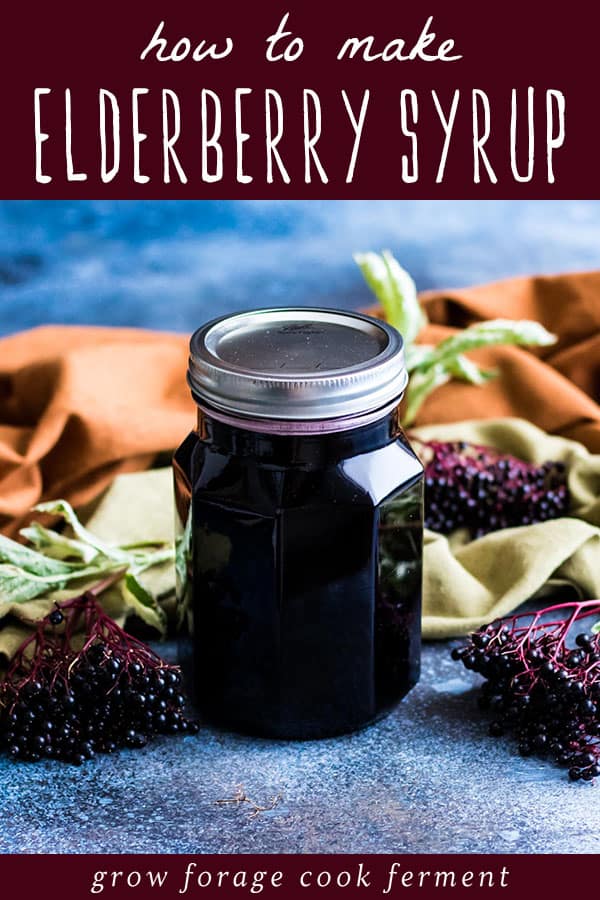
Want to save this post for later?
Elderberry Syrup Benefits
Studies have shown that elderberries have a significant effect on reducing the duration of colds and their associated symptoms. Elderberry syrup is one of the best homemade herbal recipes that anyone can make.
Elderberries contain polyphenols and lectins, which have been shown to give them the ability to inhibit coronaviruses. Although further studies are needed, the antiviral properties of elderberries have also been linked to reducing the duration of influenza.
Using elderberries to make syrup is one of the most effective ways to harness their herbal properties. Elderberry syrup is easy to make and tastes delicious. Even children love it!
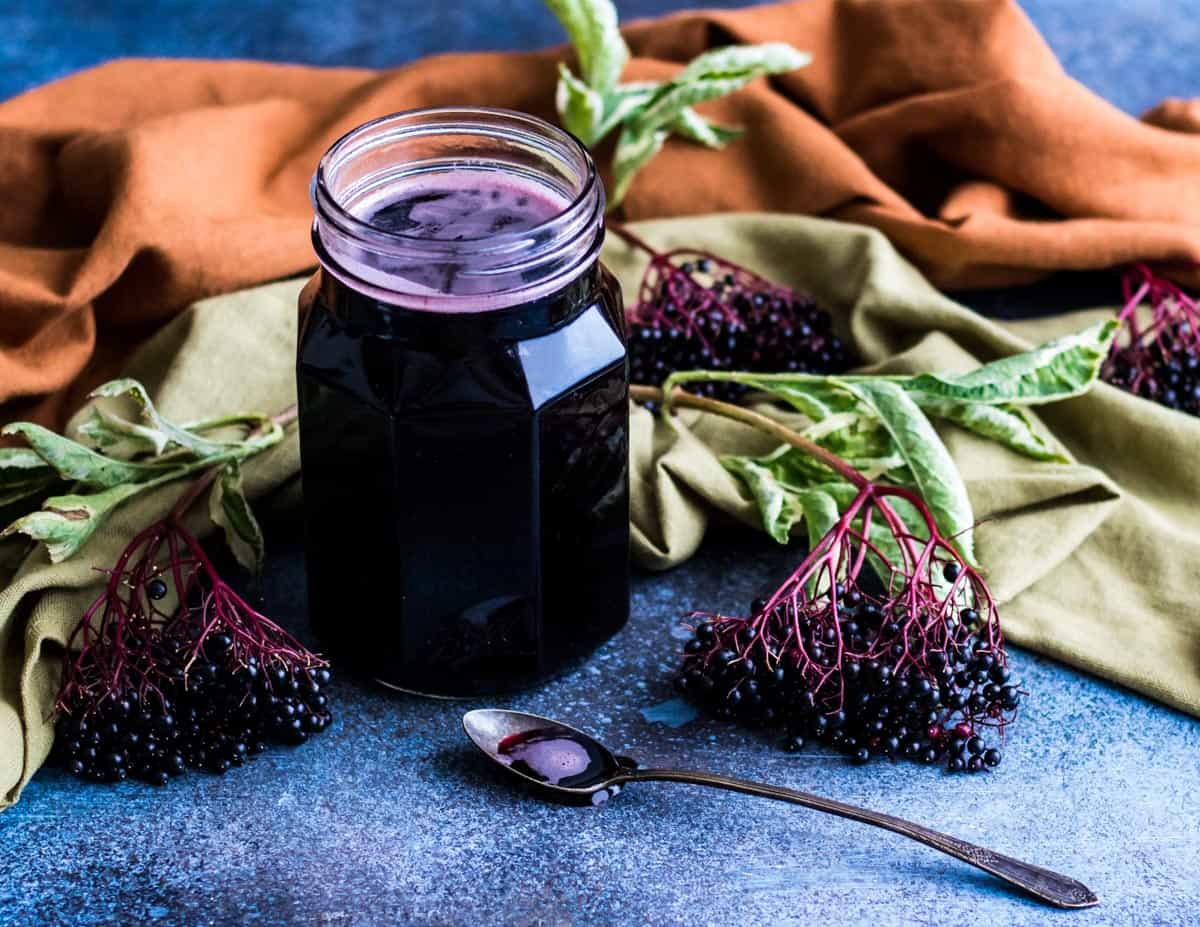
Get more winter wellness recipes for teas, infusions, syrups, honey ferments, oxymels, and gummies in my ebook Herbal Immune Support: Homemade Recipes for Wellness!
Elderberry Syrup Ingredients
This is a very simple recipe for elderberry syrup, so you only need a few ingredients to get started!
You can use either fresh or dried elderberries in this recipe.
Where to Get Elderberries
The main thing you will need to make elderberry syrup is elderberries of course! Both black or blue elderberry varieties will work.
But where to get them? There are a few options:
Foraging for wild elderberries is a great way to get them, especially if they are in season (generally August – September, depending on where you live).
You can also try growing your own elderberries in your backyard!
If you don’t have access to fresh elderberries, you can definitely use dried elderberries. (They do tend to go out of stock during the cold and flu season, so here is another source for dried elderberries).
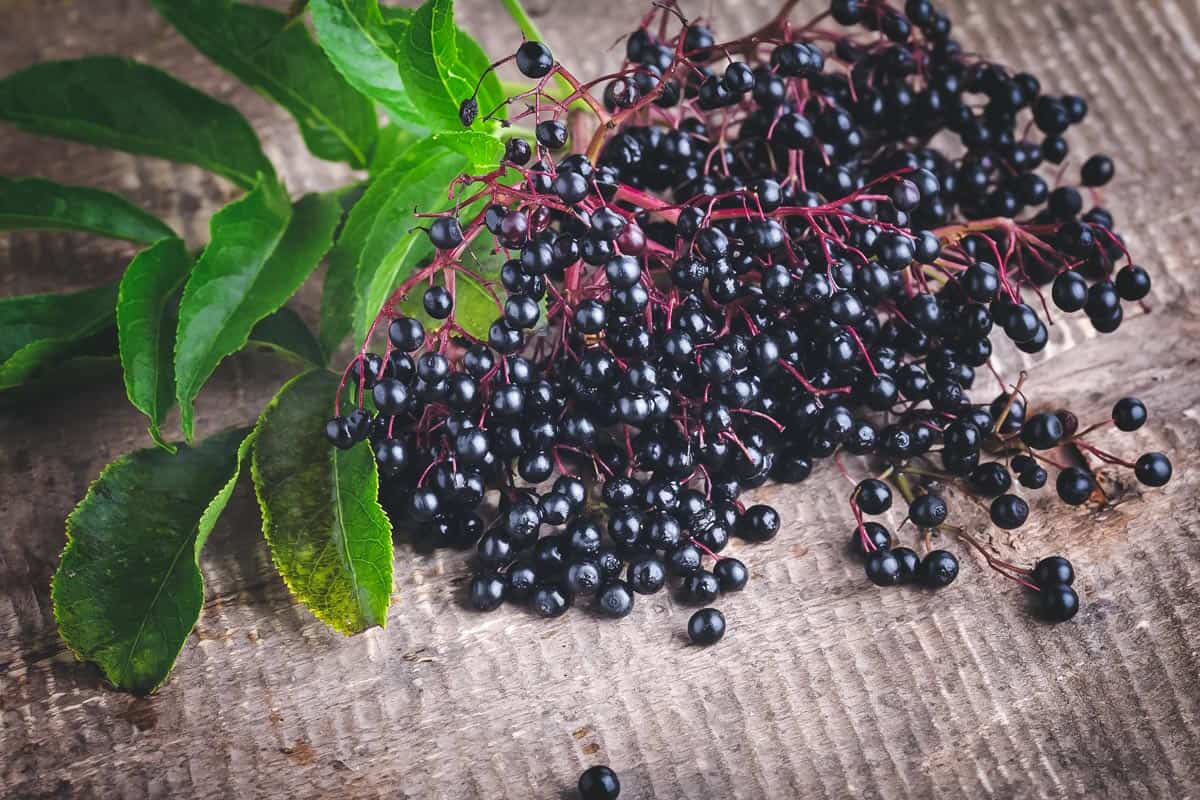
What Kind of Honey to Use
When making elderberry syrup, using raw honey is best, even better if it’s local to your region. Further studies are needed to understand the full scale of qualities that raw honey has. However, there is remarkable evidence to support the positive effects of raw honey’s antibacterial, anti-inflammatory, and antioxidant properties.
Since the honey in this recipe is never heated, all of its supportive qualities remain intact.
You can usually find local raw honey at natural food stores, farmer’s markets, or from a local beekeeper.
If you don’t have access to local raw honey, you can find high-quality organic raw honey here.
Elderberry Syrup Options
The recipe that I am sharing with you is the most basic version of elderberry syrup, but there are ways that you can customize it to your liking.
Here are a few optional ingredients you can add as you’re boiling the elderberries to make the final syrup more supportive (and more delicious in some cases):
Ginger – either fresh or dried gives it a nice flavor. Ginger has been traditionally used to support wellness and alleviate a variety of symptoms, and has been shown to be effective in the majority of studies.
Cinnamon Stick – Just like ginger, adding a cinnamon stick makes it taste delicious and has been shown to have properties that support human health in various ways.
Whole Cloves – mostly for flavor, whole cloves have also been concluded to be a rich source of antioxidant compounds.
Echinacea Root – has been shown to slightly reduce the chances of catching a cold, but echinacea doesn’t taste great.
Rose Hips – are shown to be high in vitamin C, rose hips can be foraged in the fall, or purchased dried.
Lemon – some lemon juice and/or lemon zest can be added for flavor and to boost vitamin C.
Elderberry Syrup Recipe
While this syrup is easy to make, the most difficult part is preparing the fresh elderberries, as it takes a bit of work. You may choose to use dried elderberries to make things easier!
Preparing the Fresh Elderberries
If you are using fresh elderberries, it’s important that they are completely ripe. Any unripe or green berries can have some toxins present and should be discarded.
Elderberry stems and leaves also contain some toxic compounds, so removing as many of those as possible is advised.
The best way to remove the stems from fresh elderberries is to first freeze them in whole clusters. Then you can either pop off the elderberries with your fingers, or use a fork to comb them off.
Don’t worry too much about any tiny stems that may remain, just do the best you can! Any toxins that are still present will be removed during the boiling process.
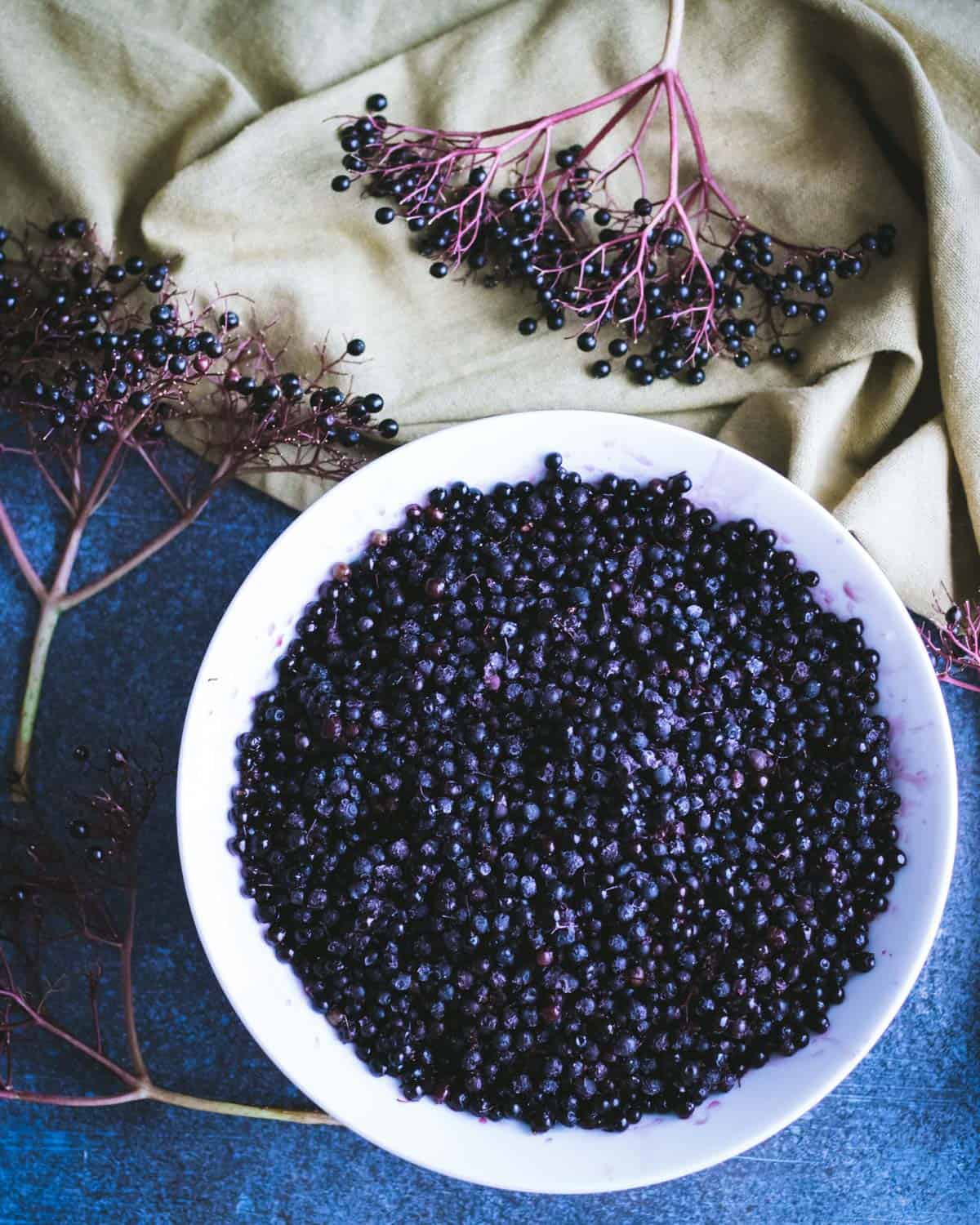
Making the Elderberry Syrup
To make the syrup, put six cups of fresh black or blue elderberries (or three cups dried) into a large pot with six cups of water.
This is also when you would add in any of the additional optional ingredients I listed above.
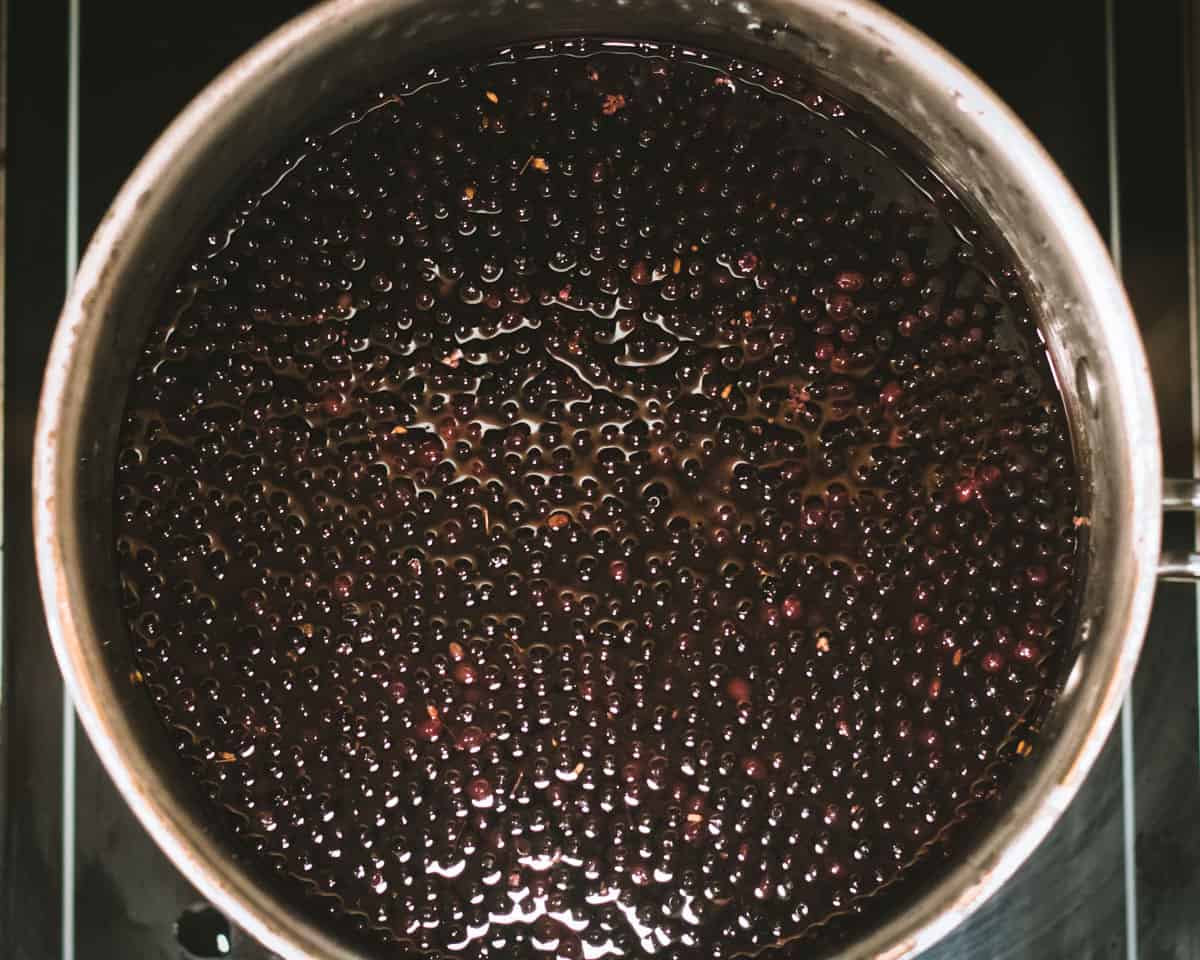
Bring it to a boil over medium heat, then lower the heat and simmer the elderberries uncovered for about one hour, or until reduced by nearly half.
It’s important to leave the pot uncovered while the elderberries are simmering, as allowing the steam to escape will help to remove any potential toxins that are present. It also helps the mixture to reduce.
If you feel like it is reducing a bit too fast, you can partially cover the pot while it is simmering.
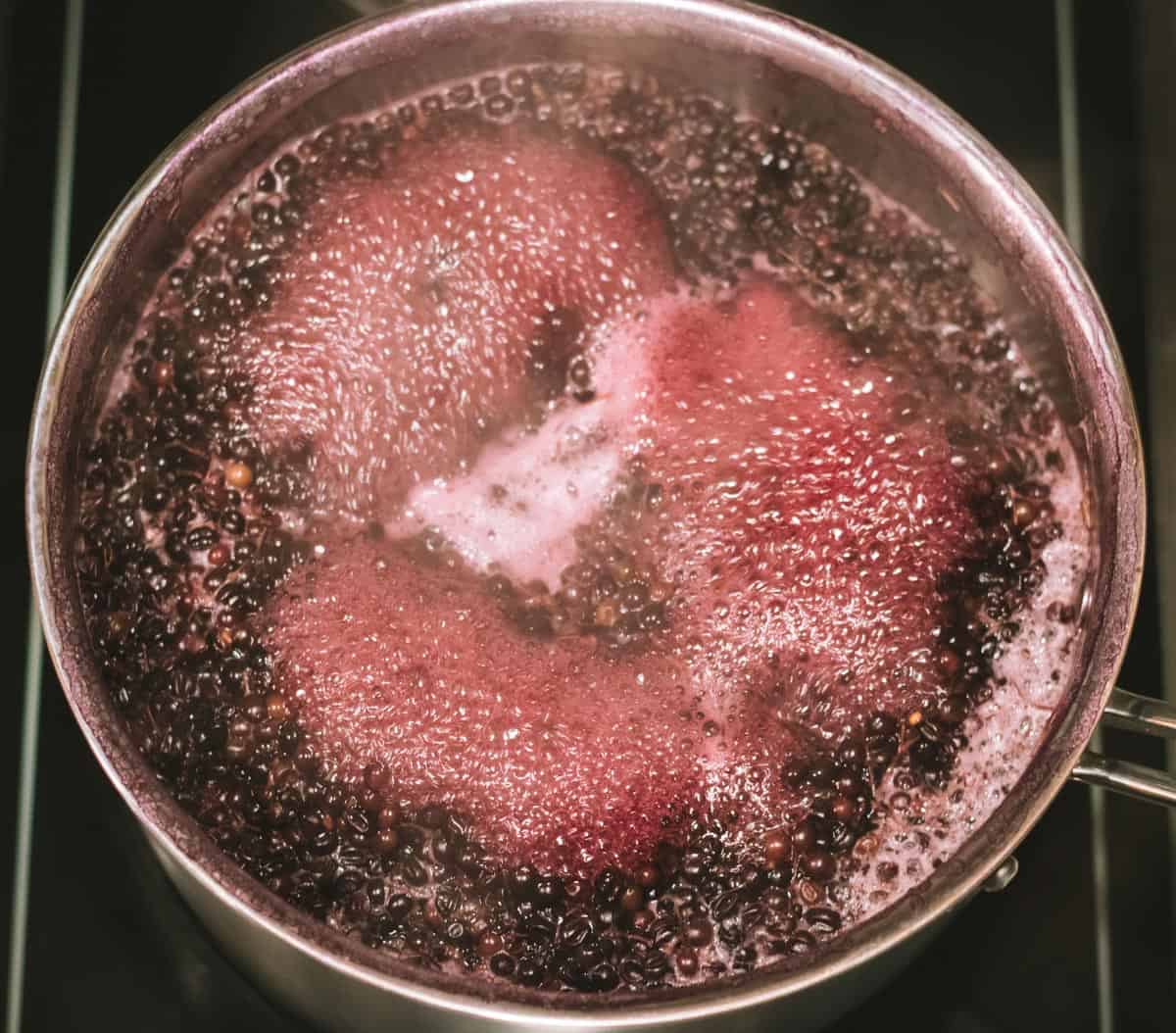
Remove the pot from the heat and set aside to cool to a warm room temperature. You want it to be warm enough to dissolve the honey, but not too hot to preserve the raw honey’s properties.
Strain out the elderberries using a fine mesh sieve, pressing the berries to get any extra liquid out.
You can line the sieve or a colander with cheesecloth if you prefer, this also helps to squeeze out all of the liquid from the berries.
You should end up with at least one quart of elderberry and water mixture.
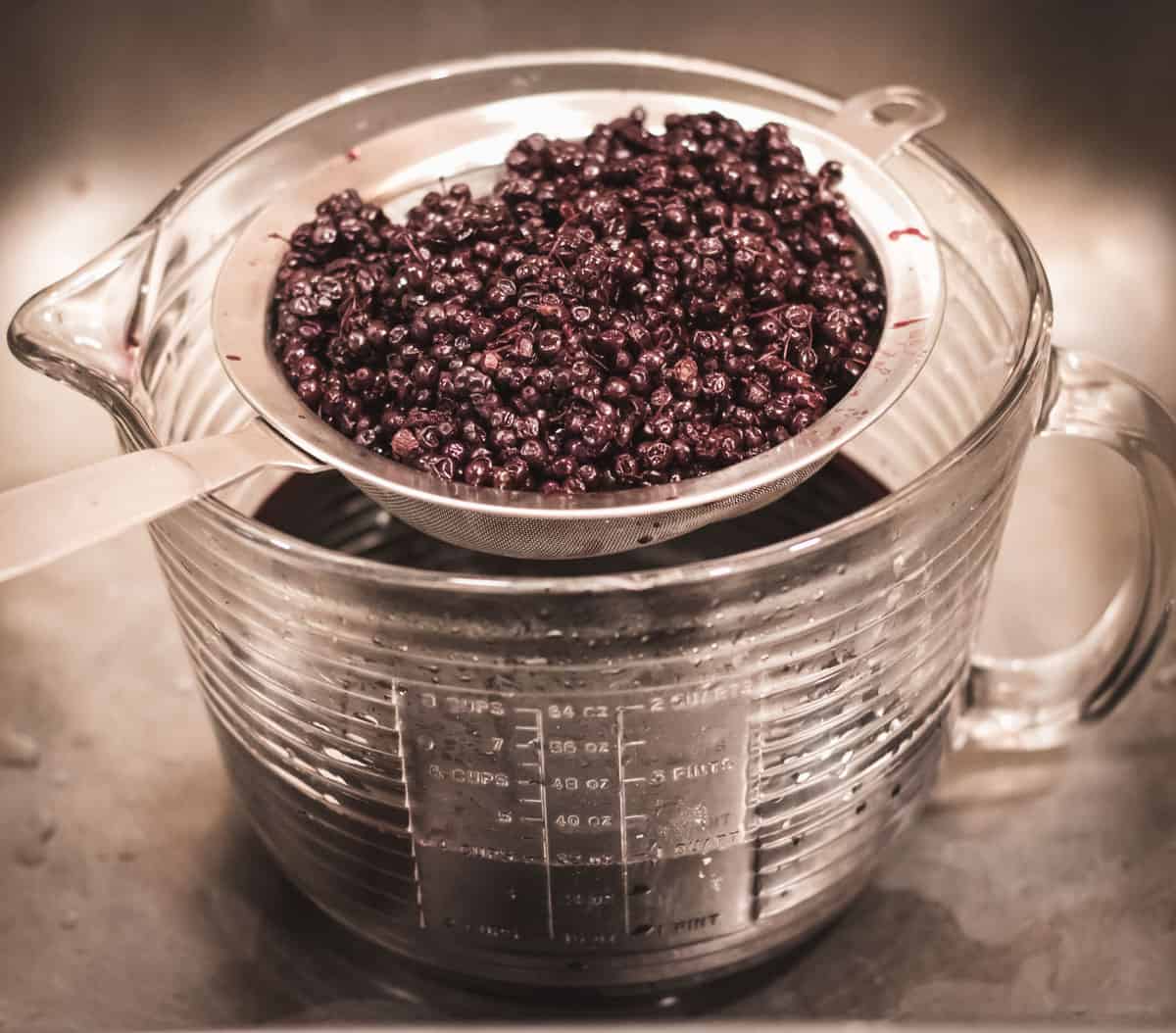
Discard the berries (put them in the compost if you have one). There really isn’t much you can do with them at this point, as all of the beneficial compounds are now in the elderberry and water mixture.
Add the raw honey and stir until it dissolves. I don’t recommend heating this again, as that would destroy the supportive compounds in the raw honey.
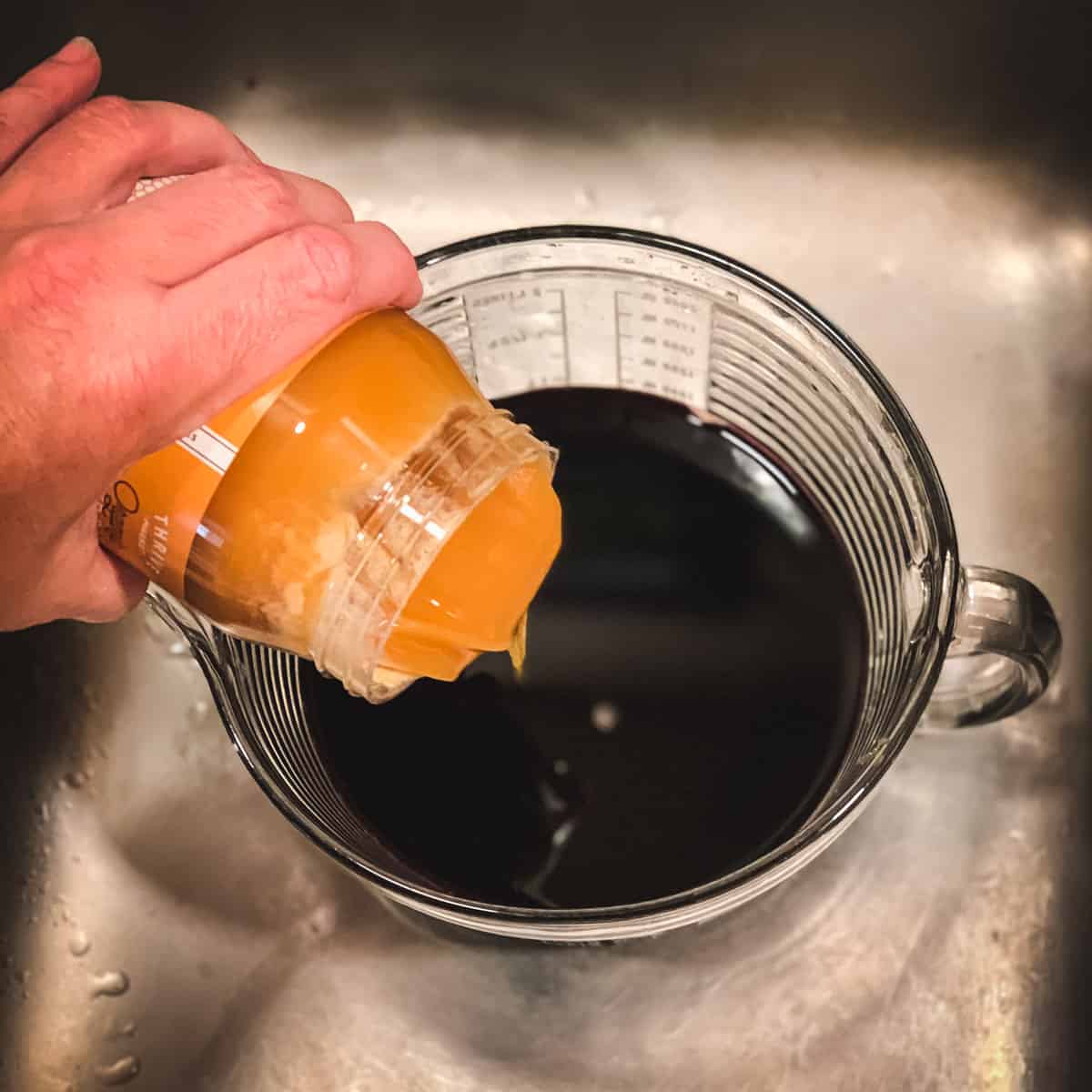
Ladle or carefully pour the elderberry syrup into quart jars (or these gorgeous sharing jars), placing the lid and ring to finger tip tight. Let it cool completely and refrigerate for up to 6 months.
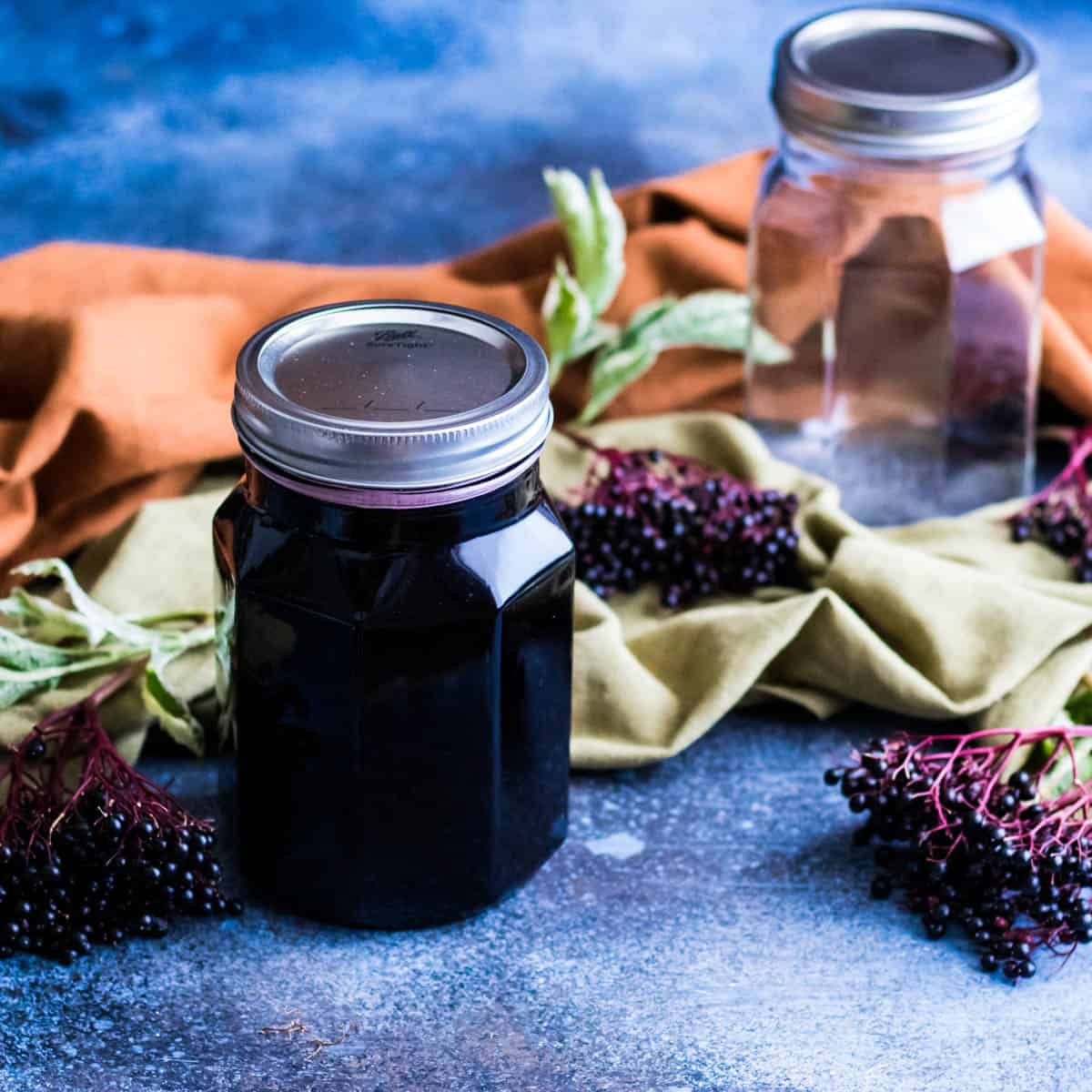
Can I Freeze This Syrup?
Yes! Elderberry syrup can be frozen for later use. I always like to make a big batch in the fall, put some in the refrigerator, and freeze the rest.
This ensures that I will have enough to last through the whole season, even into early spring, without any spoilage.
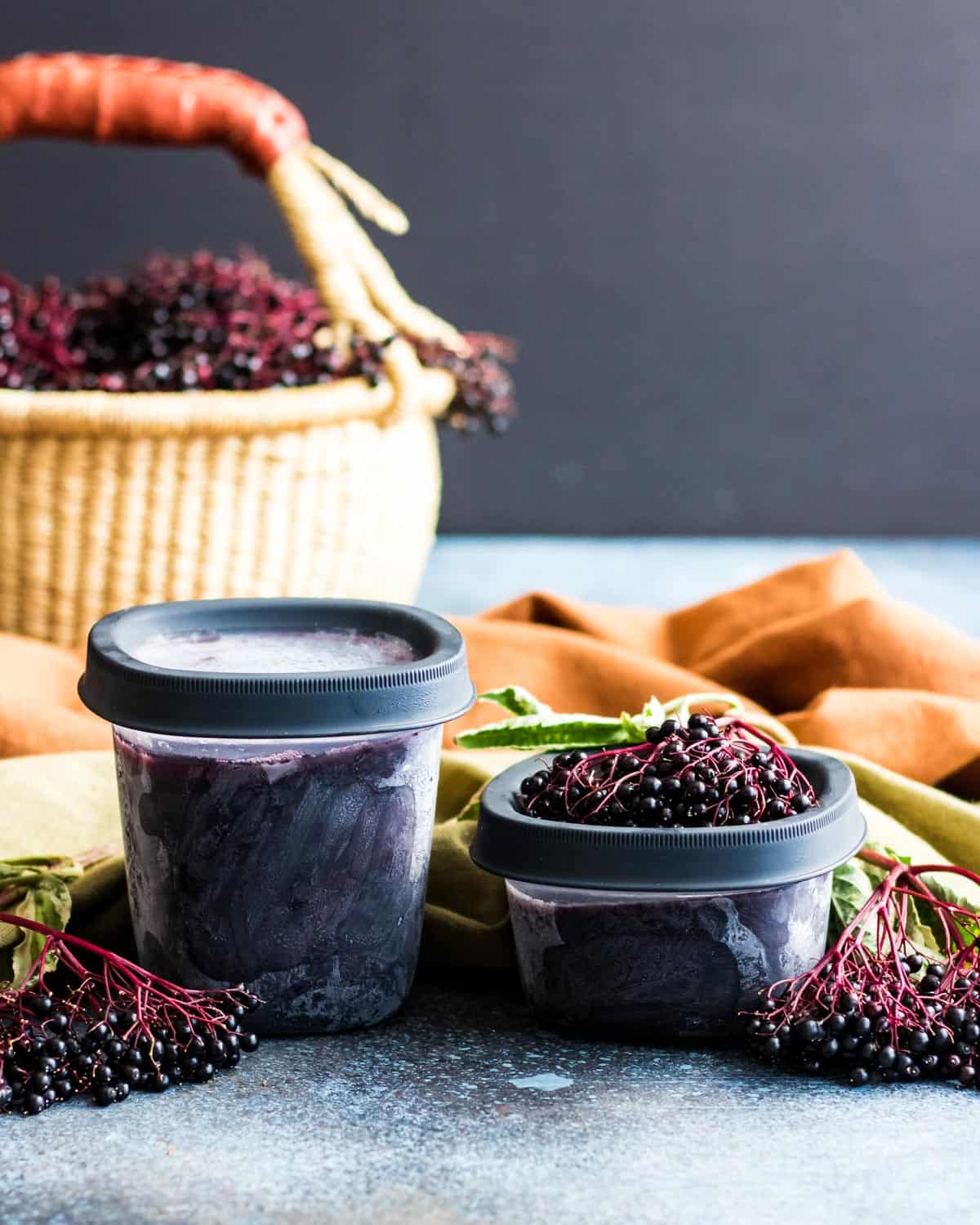
Can This Recipe be Canned?
While technically you could probably can elderberry syrup, to do it safely you would need to be absolutely sure that it had the right acidity level first. It may require more acid, like bottled lemon juice, to be added first.
I generally don’t recommend canning elderberry syrup, as this would heat the supportive properties in the raw honey, rendering them inactive.
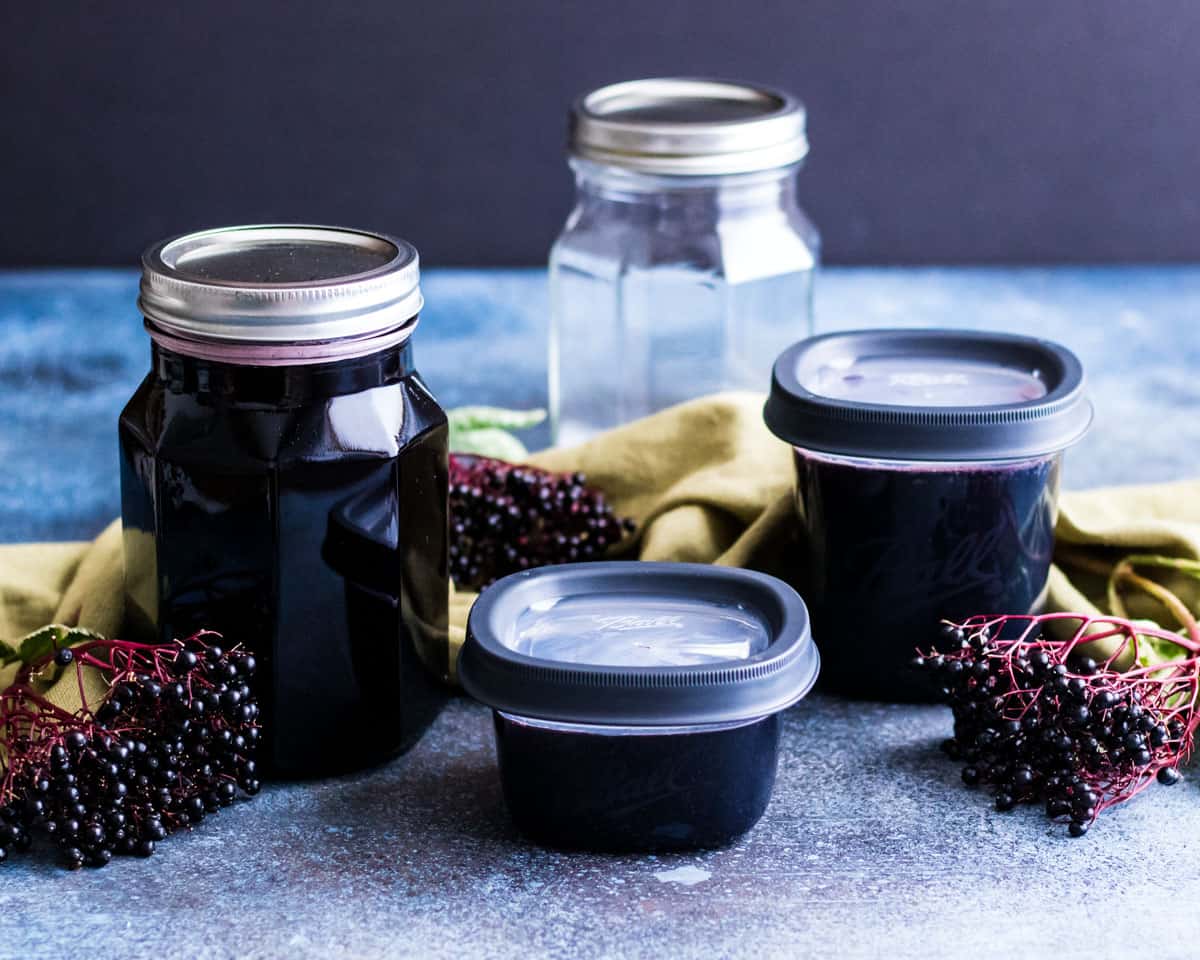
How to Use Elderberry Syrup
Elderberry syrup is a powerful herbal ally!
I recommend adults take 1-2 tablespoons of elderberry syrup 2-3 times per day at the onset of a cold or flu, and throughout the duration of the illness.
You may also take it if you feel like you were exposed to illness, even if you aren’t experiencing any symptoms yet.
I don’t recommend taking elderberry syrup daily as a preventative, as it’s been shown to potentially cause an autoimmune flare-up in some people with autoimmune disorders.
Elderberry syrup is not only extremely useful but also delicious and rich in vitamins, minerals, antioxidants, and flavonoids. It can be used in moderation as a treat on pancakes, ice cream, or stirred into cocktails, mocktails, or tea.
Is Elderberry Syrup Safe for Children?
Yes! Elderberry syrup is safe and an excellent herbal choice for children over the age of one.
Studies suggest raw honey is safe for children over 12 months of age. However, raw honey poses a risk of botulism in infants under one year old, so it should be strictly avoided.
Children over one year old may consume elderberry syrup in moderation. Some herbs may not be suitable for young children, so consulting a qualified healthcare provider before use is recommended.
While elderberry syrup is generally considered safe, dosage should be adjusted based on age and weight, and potential allergies should be taken into consideration.
Elderberry syrup can also be made into elderberry gummies or elderberry popsicles, which kids (and adults) love!
Elderberry syrup should not be given to children under the age of one due to the raw honey.
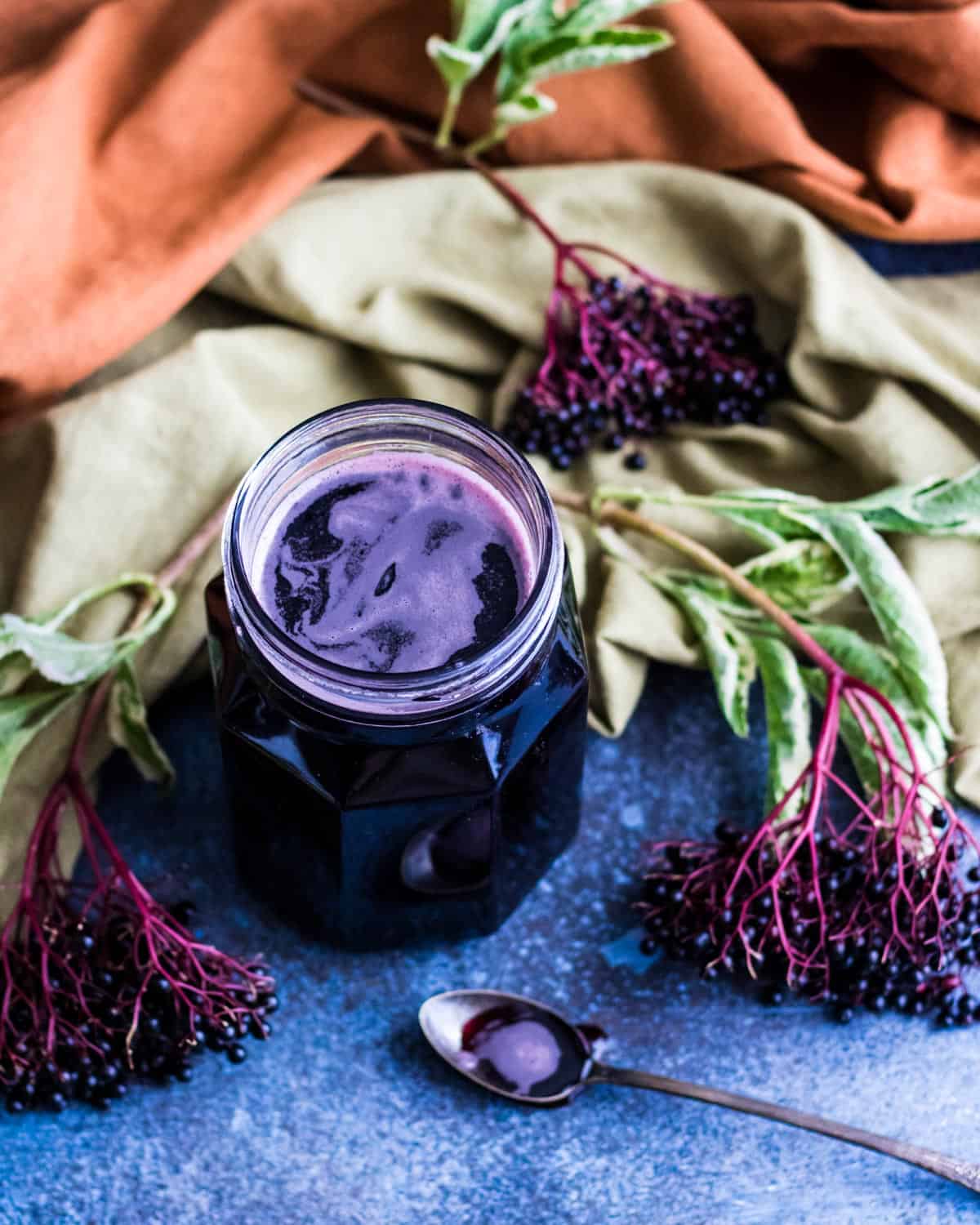
If you haven’t started making your own homemade herbal support yet, this is the perfect time to do so! And a great place to start is with elderberry syrup. It tastes delicious and has so many helpful qualities!
More Elderberry Recipes
Here are some more things you can make with elderberries!
- Elderberry Gummies
- Elderberry Popsicles
- Fermented Elderberry Honey
- Fermented Elderberry Soda
- Elderberry Mead
- Elderberry Cocktail
- Elderberry Kombucha
For even more recipes, see my post with 70+ Elderberry Recipes & Remedies for Food & Health!
Elderberry Syrup
Equipment
Ingredients
- 6 cups ripe fresh black or blue elderberries or 3 cups dried elderberries
- 6 cups water
- 2 1/2 cups raw honey
Instructions
- If you are using fresh elderberries, discard as many stems and unripe berries as possible.
- Put six cups of fresh black or blue elderberries (or three cups dried) into a large pot with six cups of water.
- Bring it to a boil over medium heat, then lower the heat and simmer the elderberries uncovered for about one hour, or until reduced by nearly half. If you feel like it is reducing a bit too fast, you can partially cover the pot while it is simmering.
- Remove the pot from the heat and set aside to cool to warm room temperature for at least 30 minutes.
- Strain out the elderberries using a fine mesh sieve, pressing the berries to get any extra liquid out. You can line the sieve or a colander with cheesecloth if you prefer, this also helps to squeeze out all of the liquid from the berries. Discard the berries. You should end up with at least one quart of elderberry and water mixture.
- Add the raw honey while the elderberry and water mixture is still semi-warm and stir until it dissolves.
- Ladle or carefully pour the elderberry syrup into quart jars, placing the lid and ring to finger tip tight. Let it cool completely and refrigerate for up to 6 months.
Notes
- It’s important to leave the pot uncovered (or partially uncovered) while the elderberries are simmering, as allowing the steam to escape will help to remove any potential toxins that are present. It also helps the mixture to reduce.
- I don’t recommend heating the elderberry syrup after the honey has been added, as that would destroy the beneficial compounds in the raw honey.
- Elderberry syrup can be frozen for later use in freezer safe containers.
- I recommend adults take 1-2 tablespoons of elderberry syrup 2-3 times per day at the onset of a cold or flu, and throughout the duration of the illness.
- For small children (ages 1-5), 1-2 teaspoons twice per day is good. That amount can be increased as the child grows.
- Elderberry syrup should not be given to children under the age of one due to the raw honey.

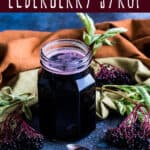
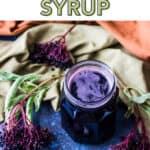
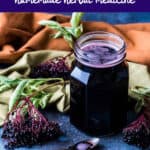
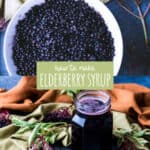
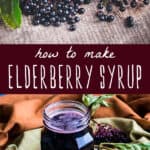
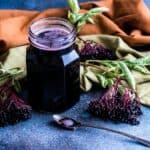

How long is it good for?
Refrigerated, 2-3 months. Frozen, much longer.
Is it okay to use frozen berries?
Looking forward to making some this weekend!
Thank you.
Yup. Enjoy!
Never-mind, I some how missed the sentence that says both blue and black will work. I was so excited I read to fast! Thanks!
No worries! Enjoy!
Love your site! I would like to ask if anything would change in this recipe if using the Blue Elderberries. That is what grows wild all around my area and I foraged a bag full :)
thank you!
Della
Hi! I am so excited to make this elderberry syrup. I have just harvested a lot of elderberries and froze them as you suggested. When started to remove the debris (little stems/twigs) from the berries, it is taking me a long time (2 hours for 1 cup). Am I being too picky? Also, should I wash the berries? They have not been near any pesticides or chemicals. Thank you!
You can rinse them if you like to remove any additional debris, but I wouldn’t be too meticulous with picking out every single stem.
An easy way to remove elderberries from the stem is to freeze them first on a cookie sheet for an hour or so. Once they’re frozen shake one bunch at a time inside a bucket or pot. The ripe ones will fall right off while the green ones remain. Please be super careful to keep any and all parts of the elderberry plant includind leafs, stems, and berries away from your pets as they are extremely toxic before processing.
Hi Heather,
Boy-oh-boy, did I get an education on harvesting elderberries this year! I re-did my berries probably three times, just to make sure I got all of the stems off. LOL. My problem was I harvested about 25% of them too early, which is a big no-no. Wait until they are completely black-purple (I found that there is usually a couple lighter ones still unripe, just pick them off).
The best way to clean them off the stems? Wash and then freeze the whole heads on a cookie sheet, then they will easily shake or pull right off. Easy peasy!
Hi!
I am gathering the ingredients to make this elderberry syrup for my kids. Could echinacea be incorporated into this or no? Their ages are 3 and 9.
Hi Kristin. Adding echinacea should be fine, but I would give very small doses to start to make sure there is no allergic reaction.
We picked elderberries in the fall of 2022 and had so many we ended up freezing a few pounds. Can I substitute frozen elderberries for fresh in this recipe?
Hi Sandra! Yes, you certainly can!
If you plan to take this daily through winter you shouldn’t add echinacea as it’s a herb that should be worked with only if your sick or getting sick to help kick start the immune system.
You don’t want to have it all the time.
Hi!
I don’t get 1 quart of elderberry water after straining the elderberries! I get quite a bit less.. once the honey is added, I get over a quart of liquid! Is this okay?
Kaylee
Hi Kaylee. That’s perfectly normal.
I just started to add all of my ingredients into the pot when I realized some of the berries that are included are green & I know that the toxins will not cook out of them after reading your blog. However, if I am just going to strain the mixture so none of the berries are in the final product then would it be ok for me to continue the cooking process or should I just scrap all the ingredients?
I tried doing my own research to judge weather this syrup would be slightly toxic due to some unripe berries but I could not find a great answer.
Thanks!
Hi Hannah. It should be fine!
Hi Colleen!
I made your elderberry syrup last week. It’s very good!
I have made so many of your recipes and from your book- I’m so grateful and love the knowledge you have put together for us all.
This page and your book are always my first go to resource for remedies and recipes.
Quick question for the elderberry syrup- since it’s been in the fridge- it’s turned to a gel/jam like consistency. Is there natural pectin in elderberries?
I will admit my cook time/method may have varied and I used the slow cooker and more water over a longer period of time.
Anywho… thanks for all you do!
Hi Cassidy! Elderberries are low in pectin, so it’s very strange it’s now a jam-like consistency. I really am not sure why that is!
I had this happen after adding rosehips to my elderberry syrup, did you add rosehips by chance?
I’m am so excited to use your recipe! I just foraged a bunch of berries. Anywho, I was reading the portion that suggested placing the spent berries in the compost. I’ve recently found a suggestion to keep the spent berries and put them in the dehydrator until nice and crispy, then use them for tea! Food for thought
Great idea!
Can we use ground herbs instead of whole? If so, what would the measurements be? This is my first time making and couldn’t find the dried herbs.
Hi Becky. Do you mean, ground elderberries?
How many oz is the finished syrup from this recipe?
It’s about a quart, so 32 oz.
Hi there! I am about to embark on making some elderberry syrup for the first time. Can you tell me how much of the following ingredients to use? Also, is there any specific type of local honey you think tastes better (wildflower, clover, sourwood)?
Ginger
Cinnamon Stick
Whole Cloves
Echinacea Root
Rose Hips
Lemon Zest
Thank you in advance! I really appreciate it.
~ Mere Bradley
Hi Meredith. It’s difficult for me to say off the top of my head how much you should use since I’ve never added those ingredients to my own elderberry syrup before. I recommend experimenting and choosing your ingredients based on your personal preferences. Wildflower honey is always good, but again, if there’s another that you prefer, go with that.
what consistency should the syrup be? I made it to a T had about a quart of liquid from the berries and the water and it is super liquidy not very syrupy is that normal? I added all of the honey. Thanks in advance.
Hi Gina. It won’t be the consistency of maple syrup. The viscosity is usually akin to cough syrup.
Can you add alcohol(vodka, brandy, etc) for a longer shelf life and if you can does it have toi be refrigerated?
I looking for a way to keep it on the counter.
Thanks si much!
Hi Louise. You would have to add quite a bit of alcohol, at least 20% to preserve your elderberry syrup. You can use any 80-proof liquor at a 1:1 ratio.
I just finished making your Winter elderflower tonic syrup and some elderberry syrup. Absolutely fabulous! I have photos of both but didn’t see where I could send them. Thanking you again. January 2022
I’m so glad you liked them! Enjoy!
Haven’t done the recipe yet-am looking for ideas and ratios. I’ve been growing organic elderberries for several years and been making tincture, shrubs and what I call “elixir”, a mixture of tincture and honey. Because of the alcohol in the tincture this will keep years in bottles at normal temperature. Last year I steam juiced much of the crop, cooked the juice down by half and then canned it. This is the juice I want to make into syrup. It won’t have alcohol so it will have to be refrigerated and used within a few months or, as you say frozen. But I do want some without the alcohol. I think I’ll try a pint of my 2:1 juice with 1/2 pint of honey. Found your site helpful.
Thank you. Enjoy!
I made a half recipe with dried elderberries. So 1 1/2 cups berries, 3 cups water. I am left with 1 cup of liquid. Is there a ratio for honey:berry liquid? You say in your recipe to have one quart of liquid, which seems like a lot after simmering for an hour. Then add 6 cups of honey. So 6 cups honey to 4 cups liquid? 3:2. 1.5 cups honey for my one cup of liquid. Is that math right?
My daughter came home from school with a sore throat, and I’ve been wanting to make the syrup myself instead of buying it. It’s extra fun because we are reading the Herb Fairies book about the elder fairy right now too!
Thank you :)
ps. I also have a jar of honey fermented jalapenos going on my counter thanks to you!
Hi Sarah. I’m not sure where you’re getting the “6 cups of honey” from? The full recipe is made with only 2 1/2 cups, so a half batch would only be 1 1/4 cups honey needed.
Hi, could you use a instant pot with the fresh berries?
Definitely!
Hello!
I just got my dried elderberries from Mountain Rose Herbs and will be making some syrup next week for the first time. I was wondering how much ginger and/or lemon you would put in? do you find that kids like ginger or lemon better in this recipe?
Thank you so much for your sharing your knowledge with us!
Hi there. I haven’t made it with either ginger or lemon, but I would probably add a half tablespoon of ginger with the berries while they simmer and stir in a tablespoon of lemon juice with the honey.
Wonderful recipes, detailed and useful. Thank you very much.
You’re welcome!
Your photography is amazing!
Thank you so much!
I have been making wild elderberry syrup for a while. I dry some of the berries and when I have lots of them fresh I boil them as for the syrup and can the juice as is. In the winter when our smallish batch runs low I used the canned juice to quickly make a fresh batch. I heat the juice, add any flavorings that I want, then cool it to around body heat and stir in my raw local honey. We are octogenarians and are not troubled with seasonal illnesses…good stuff.
Thanks for sharing, Gail!
Hello! About how many quarts does the recipe yield? Thanks!
It yields one quart!
Are they safe to have. I see that they can be poison or be toxic. How do I know when they are good to eat
They’re safe to eat as long as they’re cooked first.
I use a steam juicer for my elderberries – so much easier!
Nice, Kelly! I should get one of those!
Hello,
My freezer is full from my Covid-19 prepping. I need to can my elderberry syrup, but am un able to find the amount of lemon juice needed per jar, or batch weight. Can you point me in the right direction? The link you provided doesn’t have elderberry in their list, and I found the sight confusing. Help!
I’m sorry. Canning Elderberry syrup isn’t something I advise anyone to do after making this recipe as the canning process will kill the beneficial nutrients in the raw honey. If you have to can, this recipe looks like a good option.
You can, can the juice without any add-ins you would normally add, then add the honey after it has cooled slightly.
If you use rose hips in the elderberry syrup ,are there additional steps you need to take ? You mentioned that hips could irritating if consumed.
Hi, Brian. You wouldn’t have to change the process much. Just cook the rose hips with the elderberries. Rose hips have hairs that are irritating to some, so as long as you strain all the seeds, hairs, and elderberries out, it’ll work fine.
I want to make the syrup with echinacea root and rose hips but I don’t know what amount of each to put in your recipe. Also, is it boiled with the elderberry, or added later with the honey?
Hi Donna, I would use only a few tablespoons of dried echinacea root, as it’s pretty strong. You can use a good amount of rose hips, but it depends on how many you have. I would say one cup is good, but this is not an exact science so do what feels right to you. They would be boiled with the elderberries.
I’ve read that agave nectar can be used, or a simple syrup made at home, but I’m not positive on the amounts.
Thank you for this recipe, I will be using it this week!
You’re welcome!
Hello…can you use golden/coconut or date sugar in place of honey as vegans will be taking it. How much to use?
I haven’t tried it so I can’t give you an exact amount to use. However, I would sweeten it to your liking with coconut sugar or see if there are any vegan-friendly elderberry syrup recipes online.